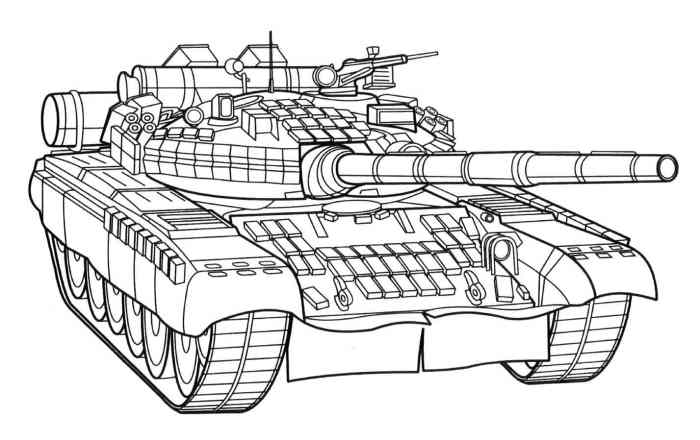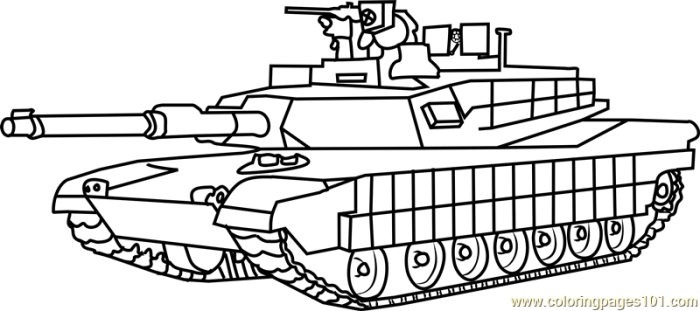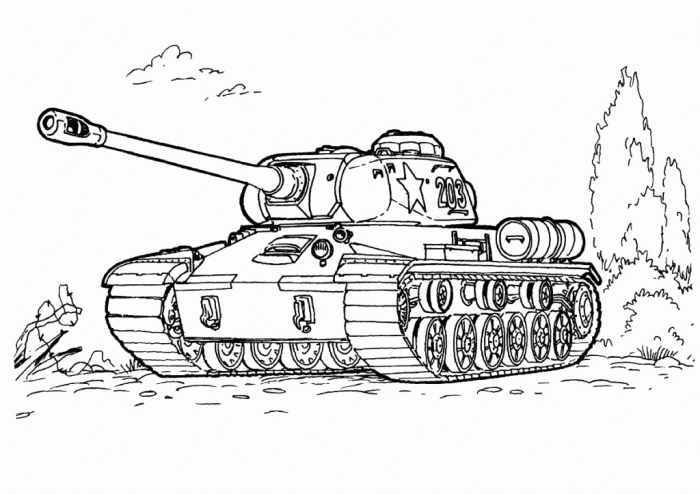Tank Coloring Page Designs for All Ages
Tank Types & Designs for Coloring Pages: Tank Coloring Page
Tank coloring page – Designing coloring pages of tanks offers a unique opportunity to explore the fascinating world of armored warfare. These pages can be engaging for children and adults alike, providing a creative outlet while subtly introducing them to military history and engineering. The following sections detail three distinct tank types suitable for coloring page designs, along with their key characteristics and historical context.
World War II Tank Design: The Sherman, Tank coloring page
The M4 Sherman, a mainstay of Allied forces during World War II, represents a classic tank design. For a coloring page, depict its relatively low profile, sloped armor (though less pronounced than later designs), and the characteristically long 75mm or 76mm gun in its turret. Show the tracks clearly, emphasizing their segmented nature. The hull should be rectangular, and the turret should be slightly rounded.
Consider including details like machine gun ports and hatches. The Sherman’s versatility and mass production made it iconic, although its armor was considered relatively thin compared to some German counterparts. The coloring page could highlight its role in major campaigns such as D-Day and the battles across North Africa.
Modern Main Battle Tank Design: The Abrams
The M1 Abrams, a prominent modern main battle tank, presents a striking contrast to the Sherman. Its coloring page should showcase its significantly more advanced design. Emphasize the composite armor, making it appear thicker and more protective. The Abrams features a powerful 120mm smoothbore gun, which should be depicted prominently. The turret is more compact and angular compared to the Sherman.
The hull is longer and lower to the ground, with additional details like side skirts and advanced sighting systems. The Abrams is known for its superior firepower, mobility, and advanced technology. The coloring page could be enhanced by illustrating details such as thermal sights or reactive armor.
Light Tank Design: The Stuart
The M3 Stuart, a light tank used extensively by the Allies during World War II, provides a third distinct design for a coloring page. In contrast to the Sherman and Abrams, the Stuart is smaller and more agile. Its relatively thin armor should be apparent, and its smaller main gun (37mm or 75mm) should be accurately represented. The turret is typically rounder than the Sherman’s, and the overall silhouette is more compact.
The tracks are similarly detailed but thinner than the Sherman’s. Its speed and maneuverability made it valuable for reconnaissance and flanking maneuvers. The coloring page should highlight its speed and lighter weight.
Tank Design Comparison
The following table compares the three tank designs, highlighting key differences:
| Feature | Sherman (WWII) | Abrams (Modern) | Stuart (Light WWII) |
|---|---|---|---|
| Armor | Welded steel, relatively thin | Composite armor, significantly thicker | Welded steel, very thin |
| Weaponry | 75mm or 76mm gun | 120mm smoothbore gun | 37mm or 75mm gun |
| Silhouette | Low profile, somewhat rectangular | Low profile, angular | Compact, relatively high |
Coloring Page Complexity & Age Appropriateness

Designing coloring pages for tanks requires consideration of the target age group to ensure an engaging and appropriately challenging experience. A simple design is ideal for younger children, while a more complex design caters to the skills and interests of older children. This approach ensures that each age group can enjoy the activity without frustration or boredom.Creating age-appropriate coloring pages involves careful consideration of several factors including the complexity of the design, the size of the shapes and lines, and the level of detail.
This ensures that the activity remains both fun and educational, promoting fine motor skills and creativity.
Simple Tank Coloring Page for Young Children (Ages 3-5)
This design prioritizes large, easily colored shapes and minimal detail. The tank would be depicted as a simple rectangle for the body, with a circle for the turret. The tracks could be represented by two simple, thick, parallel lines. Wheels would be omitted, and any additional features like a cannon would be very basic, perhaps just a simple rectangle on top of the turret.
The lines used would be thick and bold, making it easy for young children to stay within the lines and color without difficulty. The overall color palette would be limited to a few bright, primary colors. Imagine a friendly, cartoonish tank, more reminiscent of a toy than a military vehicle.
Complex Tank Coloring Page for Older Children (Ages 8-12)
A coloring page designed for older children incorporates more intricate details and realistic features. This tank would include a more detailed representation of the body, with various panels, rivets, and hatches indicated. The turret would be more accurately shaped, and the cannon would be fully rendered, potentially with additional smaller details like sights. The tracks would be more realistically depicted, possibly with individual links suggested.
Intricate patterns, such as camouflage or geometric designs, could be incorporated onto the tank’s surface. Thinner lines and finer details would require more precision and control, challenging older children’s fine motor skills. A more realistic color palette, including shades and variations, would be suitable. This design could even include a detailed background, such as a battlefield or landscape.
Comparison of Simple and Complex Tank Coloring Pages
The differences between the simple and complex coloring pages are significant, impacting the overall experience for the child. Here’s a comparison in a bulleted list:
- Line Thickness: The simple design uses thick lines, while the complex design uses a variety of line thicknesses, including thin lines for detail.
- Detail Level: The simple design has minimal detail, focusing on basic shapes. The complex design is highly detailed, with numerous features and patterns.
- Visual Appeal: The simple design is simplistic and cartoonish, appealing to younger children. The complex design is more realistic and intricate, appealing to older children who appreciate greater detail and challenge.
- Color Palette: The simple design uses a limited palette of bright primary colors. The complex design incorporates a broader palette with shades and variations for a more realistic effect.
- Overall Complexity: The simple design is easy to color and requires minimal fine motor skills. The complex design presents a greater challenge, requiring more precision and control.
Illustrative Styles for Tank Coloring Pages

The choice of illustrative style significantly impacts the overall aesthetic and target audience of a tank coloring page. Different styles cater to varying age groups and artistic preferences, offering unique creative opportunities. This section will explore two distinct styles: realistic and cartoonish, detailing their characteristics and intended users.
Realistic Tank Coloring Page
This style prioritizes accuracy and detail, mirroring the appearance of real tanks. A detailed example could feature a World War II Sherman tank. The coloring page would include intricate depictions of the tank’s tracks, turret, gun barrel, and other components. The level of detail would be substantial, allowing for nuanced shading and highlighting to create a three-dimensional effect.Shading techniques for this style would involve employing a range of grays and dark tones to create depth and form.
Hatching, cross-hatching, and stippling can be used to depict shadows and texture. For example, the treads could be shaded to show the curves and individual links, while the turret could be shaded to indicate its metallic surface. Highlights would be added using lighter shades or even white to simulate light reflecting off the tank’s surfaces. This would create a sense of realism and challenge older children and adults who appreciate detailed artwork.
Cartoonish Tank Coloring Page
In contrast to the realistic style, a cartoonish tank coloring page would utilize exaggerated features and simplified shapes. Imagine a tank with oversized wheels, comically large gun, and perhaps even anthropomorphic features like googly eyes and a smiling mouth. The overall aesthetic would be playful and lighthearted. The style could be inspired by classic cartoon designs, featuring bold Artikels and bright, primary colors.
This style emphasizes simplicity and fun, making it easily accessible to younger children.This style’s key characteristics are its simplified shapes, bold Artikels, and exaggerated proportions. Details would be minimalized, focusing instead on the overall visual impact. The coloring page would be easy to color, with large areas for crayon or marker application. The overall aesthetic would be bright and cheerful, aiming for an immediate visual appeal.
Aesthetic Appeal and Target Audience
The realistic tank coloring page appeals to older children (ages 10 and up) and adults who appreciate detail and realism. The challenge of accurately rendering the shading and details provides a satisfying creative experience. The complexity of the design caters to those seeking a more involved coloring activity. In contrast, the cartoonish tank coloring page is ideally suited for younger children (ages 3-9).
Tank coloring pages offer a fun way for children to explore military vehicles. If you’re looking for a simple starting point before tackling complex tank designs, consider practicing letter formations first, perhaps with a helpful resource like this letter t coloring page. Mastering basic shapes improves hand-eye coordination, which is beneficial when later moving on to the more intricate details of a tank coloring page.
The simplified shapes and bold Artikels make it easy to color, encouraging creativity without the frustration of intricate details. The playful and whimsical nature of the design is also more appealing to younger audiences.
Incorporating Backgrounds and Scenery
Adding appropriate backgrounds to tank coloring pages significantly enhances their visual appeal and provides context for the featured military vehicles. A well-designed background complements the tank, creating a more engaging and immersive coloring experience for children. Careful consideration of color palettes and composition techniques is crucial for achieving a balanced and visually pleasing result.Effective background design involves selecting a setting that is both relevant to the tank’s historical context or fictional universe and aesthetically pleasing.
Overly complex or detailed backgrounds can distract from the main subject, the tank itself. Therefore, a balance between detail and simplicity is essential.
Desert Environment Background
This coloring page features a tank positioned amidst rolling sand dunes under a clear, bright sky. Several cacti of varying sizes are scattered throughout the scene, adding visual interest and reinforcing the desert setting. The color palette is predominantly warm, employing sandy yellows and oranges for the dunes, a deep blue for the sky, and varying shades of green for the cacti.
The tank itself could be a muted olive green or a sandy beige to blend seamlessly with the environment. The composition uses a rule of thirds approach, placing the tank off-center to create a more dynamic and visually appealing arrangement. The dunes are depicted with subtle shading to suggest depth and texture, while the cacti add vertical lines that contrast with the horizontal lines of the dunes and the tank.
The clear sky provides a sense of vastness and openness, emphasizing the tank’s presence in the expansive desert landscape.
Forest Environment Background
In contrast to the desert scene, this coloring page showcases a tank nestled within a dense forest. Tall trees with varying foliage create a sense of depth and shadow. Bushes and undergrowth are subtly included to fill in spaces and provide additional visual texture. The color palette for this scene is cooler and more muted. Deep greens and browns dominate, with shadows rendered in darker shades to create a sense of mystery and depth.
The sky is partially obscured by the tree canopy, suggesting a cloudy or overcast day. This contributes to the overall mood of the page, creating a more subdued and atmospheric feel. The composition uses overlapping elements to create depth. The trees are layered, with those in the foreground appearing larger and more detailed than those in the background.
The tank is positioned strategically to allow the viewer’s eye to travel through the scene, creating a sense of journey and exploration. The overall effect is a harmonious balance between the tank and its environment.
Additional Design Elements

Enhancing tank coloring pages beyond basic Artikels involves incorporating additional design elements to increase visual appeal and engagement. These elements can range from complex camouflage patterns to the inclusion of supporting characters and military paraphernalia, ultimately creating a richer and more dynamic coloring experience. Careful consideration of font choices for any added text also contributes significantly to the overall aesthetic.
Camouflage Patterns on Tank Coloring Pages
This section details different camouflage techniques commonly used on tanks and how to represent them effectively in a coloring page design. The goal is to provide a visually stimulating and educational experience for the user, allowing them to learn about different camouflage strategies while coloring.
Example 1: Disruptive Camouflage: This pattern uses irregular shapes and contrasting colors to break up the tank’s Artikel, making it harder to spot against a varied background. Imagine a tank with large, angular patches of olive green, brown, and beige, irregularly placed to create a visually chaotic but effective camouflage. The coloring page could provide a pre-Artikeld pattern or leave it open for the user to create their own disruptive pattern within the tank’s shape.
Example 2: Splatter Camouflage: This technique involves applying irregular blotches of color to mimic the effect of mud, dirt, or other natural elements. For the coloring page, this could be represented by pre-drawn irregular splotches in shades of brown, dark green, and black, overlaid on a base coat of a more solid color, allowing the user to color in the splotches and adjust the intensity of their color.
It could mimic the look of a tank that’s seen some action.
Example 3: Abstract Camouflage: Modern camouflage often uses complex geometric patterns. A coloring page could feature a tank with an abstract pattern of sharp angles, lines, and contrasting colors, potentially incorporating more modern colors like grey, dark blue, and muted greens. The user would color in these already-Artikeld geometric shapes.
Adding Soldiers, Explosions, and Military Paraphernalia
Incorporating additional elements such as soldiers, explosions, and other military equipment can significantly enhance the narrative and visual interest of the coloring page. Strategic placement and stylistic choices are key to creating a cohesive and engaging scene.
The placement of these elements should be carefully considered to avoid overwhelming the main subject, the tank. For instance, soldiers could be positioned flanking the tank, perhaps in a defensive or offensive posture. An explosion could be depicted behind the tank, suggesting recent combat. Military paraphernalia, such as ammunition boxes or barbed wire, could be subtly added to the background to enhance the overall military setting.
The style of these elements should be consistent with the overall style of the coloring page. Simple, easily colorable Artikels are ideal, avoiding intricate details that might be too challenging for younger users.
Font Selection for Text on Coloring Pages
The choice of font significantly impacts the overall aesthetic of a coloring page. Different fonts evoke different moods and styles.
Example 1: Bold Sans-serif fonts (like Arial Black or Impact) create a strong, modern, and easily readable feel. These are good for titles or short, impactful descriptions.
Example 2: Elegant Serif fonts (like Times New Roman or Garamond) provide a more classic and sophisticated look, suitable for longer descriptions or historical context.
Example 3: Playful Script fonts (like Edwardian Script ITC or Lucida Handwriting) can add a whimsical or personal touch, suitable for less formal coloring pages or those aimed at younger children. However, readability should be prioritized; overly decorative scripts can be difficult to read.
The chosen font should be easily legible, even when colored in. Avoid overly thin or delicate fonts that might be difficult to fill in without smudging.





















